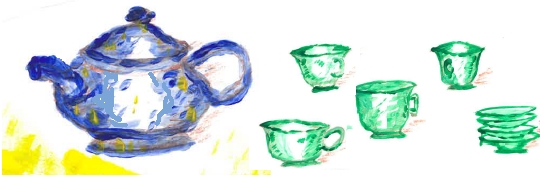
Grammar is a system. You can’t see it, you can’t touch it, you can’t smell it, you can’t hear it – not directly. All you can do is infer it, infer it as an abstract entity and infer how it works in itself and in relation to other parts of the language you are using. Some have said that, when we are born, we already have a grammar, or at least a sense of grammar, a blueprint of what grammar is and that we then modify that universal, innate sense of grammar to match it up to the grammar of the language or languages we hear as a language-learning child. In that sense, grammar, the notion of grammar starts as an innate capacity open to specific definition and modification much like our seemingly innate capacity for experiencing emotions, feelings, colours and patterns. There may be some truth in that but only, I think, insofar as we have an innate capacity for understanding mutually shared notions of systems in the sense that just as love is a system, fear is a system, pain is a system, so grammar is a system.
But, what is a system? The short answer is that it is something that can often be very complex in its workings and that is used to achieve an end, a goal, a purpose on each occasion of its use or generally, forever.
A concrete system
We can be more specific, though. A system is made up of three elements: a structure, a purpose, and a process. A concrete thing like a computer keyboard is a system and is part of a system. It has a structure of keys that relate to a pre-defined configuration of symbols. It has a purpose of transmitting signals that we control to a computer that sends them to a monitor that shows the symbols in the sequence that we have selected; and, there is a process involved of our pressing the keys to trigger the sequence of symbols that we want to appear on the screen (as I am doing now).
An abstract system
Grammar is an abstract system, of course, but it has huge psychological reality and, to some degree, our learnt grammar defines our psychological reality. It has a structure or, rather, a set of interconnected structures and it provides a way of structuring experience. Grammar, generally across languages, provides scope for an awareness of two key types of structuring: the analytic and the synthetic. What do we mean by ‘analytic’ and ‘synthetic’? Well, I would say these are quite intellectual-seeming words for very simple concepts. This contrast is so fundamental to the way we habitually think and feel that we are very largely unaware of it; it is so integral to our thinking and feeling processes that we are largely unconscious of it. But, let’s ‘surface’ this contrast somewhat, thus: let’s say I’m going to give a tea party for some friends; I get out my best teapot and then I complement it with my finest teacups; I have started to prepare a tea set. I have enacted a synthetic action; I have put together different items to form a set, a whole, a coherence. But, let’s say I have a change of heart and I don’t like the blue teapot with the green teacups. I then replace the blue teapot with my green one; I have now completed an ‘analytic’ act: I have substituted green for blue. This distinction is fundamental to understanding the basic structuring operating within grammar.
Now, what’s more, grammar has not only an internal structure but also a purpose, which is to enable words, in conjunction, to convey levels and types of meaning, that individual words in themselves cannot convey. For (almost) any thought or feeling we may have, grammar enables us to use words to express it in a way that we can understand and that others can understand; grammar’s purpose, in other words, is to enable the infinite generation of coherent self-expression and communication – coherence, here, means that the ideas expressed are completely or nearly coherent with what is in our heads and hearts and is also coherent with the scope for thought and feeling in others.
An aside: we could, theoretically, have a word for every possible experience, every thought, every idea, every feeling imaginable throughout evolution (past, present and future), but the demands on our memory would be exponential and this vocabulary would always have a limit to its size – it could never be infinite, since vocabulary does not have rules enabling infinite generation. If it did, it would then be a grammar.
Finally, grammar works in a process. We use grammar consciously or unconsciously and, it would seem, much of what we do with grammar is through a process of unconscious awareness – as non-specialists, we are aware of the rules of grammar, for example, but we are unconscious of that awareness and often can’t explain it – strange but true. In the process of using grammar, we are taking elements of language, mostly words, and combining them into wholes of structured meaning, often with huge subtleties of meaning and even ‘shadedness’ of meaning. In actual fact, we are moving up and down between the synthetic and analytic levels of grammatical structuring and slot-filling with incredible speed (skipping between the levels in our thinking) and in a state of cognitive synchronicity (thinking at both levels simultaneously).